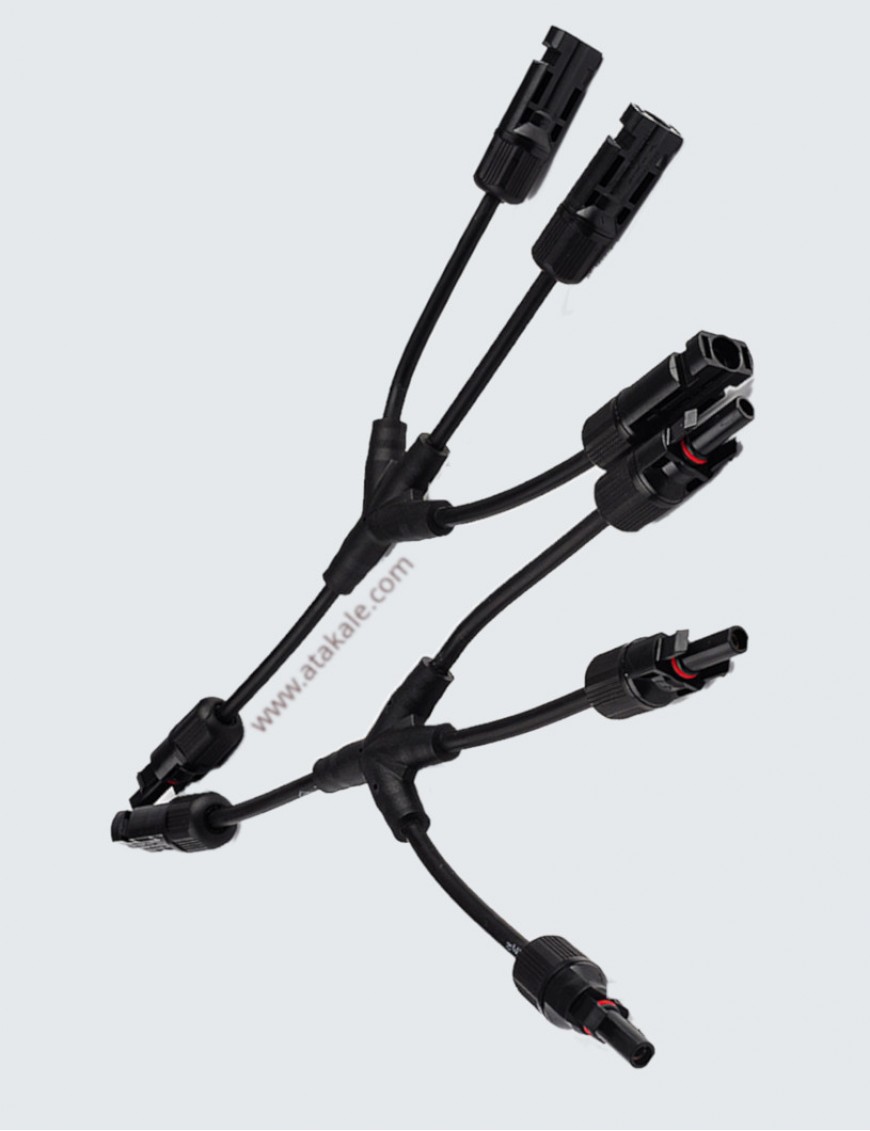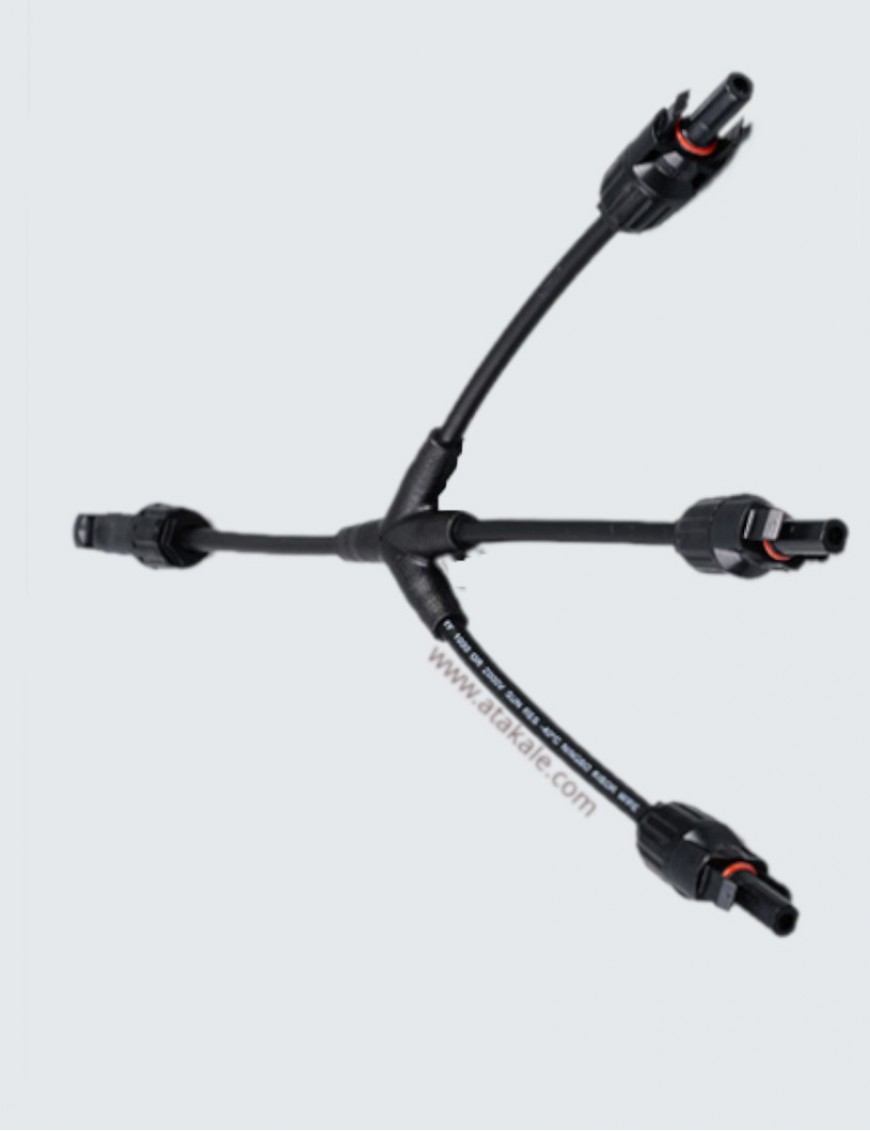Profesyonel Proje Ürün Gurubudur. Ürün sipariş edildiğinde sizin için 7 gün içinde üreticiden /ithalatçıdan tedarik edilerek özel sipariş olarak gönderilecektir. Aceleniz var ise lütfen iletişme geçerek stok öğrendikten sonra satın alınız. Son Kullanıcı Tüketici Elektronik Ürünü Değildir. Satın Alma Şartları , değişim , iade ve garanti şartları tüketici korunma haklarınını içermez. Ticaret Kanunu hükümleri geçerlidir. Sadece bayi ve tüccarlara satış yapılmaktadır. Satın alan kişi bu ürünü kullanmaya yeterli bilgisi ve eğitimi yok ise almamasını tavsiye ediyoruz.
Custom ,Gümrük Tarife GTIP Number:8536690000
PV-MC4-3F1M Dişi+Dişi=Erkek (Pozitif+Pozitif=Negative)
PV-MC4-3M1F Erkek+Erkek=Dişi (Negatif/Eksi+Eksi=Pozitif)
Güneş Paneli Y Branş konnektörleri, güneş panelleri arasındaki paralel bağlantı için tasarlanmıştır. Kablolu olduğundan dolayı birbirinden uzak mesafedeki panelleri birleştirme esnasında kolaylık sağlar.
-Güneş paneli paralelleme konektörü, Y tipi 3 dallı güneş konektörü MFFF/FMMM, güneş fotovoltaik sistemi için uygundur. (1 erkekten 3 dişi ve 1 dişi 3 erkeğe)
Yüksek kaliteli malzemeden üretilmiştir, düşük temas iç direnci, su geçirmez, toz geçirmez, deforma olmaz, yüksek ve düşük sıcaklık direnci vb. özelliklere sahiptir, uzun süreli dış mekan kullanımına uygundur. Farklı ışık koşulları nedeniyle boyut ve renkdeğişikliklerine uğrasada göreini yapmaz.
-Karmaşık ve dağınık kablolama yapılarını önler
-Hızlı ve kolay bağlantılarla zamandan ve işçilik maliyetlerinden tasarruf etmenizi sağlar
-Ek panelleri zahmetsizce ekleyerek sistem genişletmeyi sağlarsınız
PV modüllerinin güvenli ve basit paralel veya seri paralel bağlantısı için T Paralelleme aparatları kullanabilirsiniz.
Ürünerin tamamı CE, TUV tarafından onaylanan Solar T Stil Branşman Konnektörleridir. Birden fazla güneş panelini veya güneş paneli grubunu bir güneş alanında birbirine bağlamak için kullanılırlar ve sertifkalya sahiptir.
Ürün Özellikleri
-PV modüllerinin güvenli ve basit şekilde paralel veya seri paralel bağlantısı için imal edilmiştir.
-1 Çift (1 ila 6 arasında paralel bağlantı çeşitlerine sahiptir.) Güneş Paneli Kablo Konektörü (bir dişiden üç erkeğe (F/MMMMMM) ve bir erkekten üç dişiye (M/FFFFFF)
-tüm dünaydaki MC4 standartlarndaki ürünler için uyumludur
-en ağır şartlarda 25 sene ömüre sahiptir.
-Mükemmel yaşlanma direnci ve UV dayanıklılığı ile dış ortam ve güneş ışınlarına maruz kalan yerler için uygundur.
-t Branş konnektör conta sayesinde, toz geçirmez tasarıma sahitpir.
-Büyük akım ve yüksek gerilim ile yük kapasitesine sahiptir. 50a güvenle kullanılacak akım değerine sahiptir.
-Hızlı ve basit montaj işlemi ve herhangi bir ekstra alet yardımı olmadan fişlerin kolayca çıkarılıp takılması mümkündür.
-Güçlü çekme yüklerine dayanır.
-Ekstra yüksek sıcaklıklarda yanmadan kullanılabilir. Ve düşük sıcaklıklarda görevini yapar.
-Paralelleme esnasında geçen akıma karşı çok düşük temas direnci sayesinde ısınma oluşturmaz.
-Yüksek akım taşıma kapasitesi sayesinde 4 adet dizenin akım değerine uygun tasarlanmıştır.
Teknik parametreler:
-Kablo özellikleri: 4mm2/6mm²/10mm² (AWG12)
-Anma Akımı: 50A
-Anma gerilimi: TUV 1000VDC/UL 600VDC
-Kontak direnci: ≤0,2mmΩ
-Su geçirmezlik derecesi: IP67
-Alev sınıfı: UL94-VO
-Güvenlik Sınıfı: 2
-Çekilme kuvveti: ≥50N
-Yerleştirme kuvveti: ≤50N
-Yalıtım malzemesi: PPO + PA
-Bağlantı sistemi: sıkma bağlantısı
-Sıcaklık aralığı: -40 ºC ~ +90ºC
-Opsiyonları : 6 yollu/5 yollu/ 4 yollu/ 3 yollu/ 2 yollu (İsteğe bağlı)
Renk:Siyah renk
Pin Meteryali:Kalaylı Pirinç
Konnektör sayılarına göre Paket Boyutu:
5 yollu: 20*13*2cm / 7.87*5.12*0.79in
4 yollu: 19*12*2 cm / 7,48*4,72*0,79 inç
3 yollu: 16*11*2 cm / 6,30*4,33*0,79 inç
2 yollu: 15*8*2 cm / 5,91*3,15*0,79 inç
Paket ağırlığı:
6 yönlü:269g/10.23oz
5 yönlü: 234g / 8,26oz
4 yönlü: 198g / 6,96oz
3 yönlü: 150g / 5,29oz
2 yönlü: 109g / 3,84oz



























